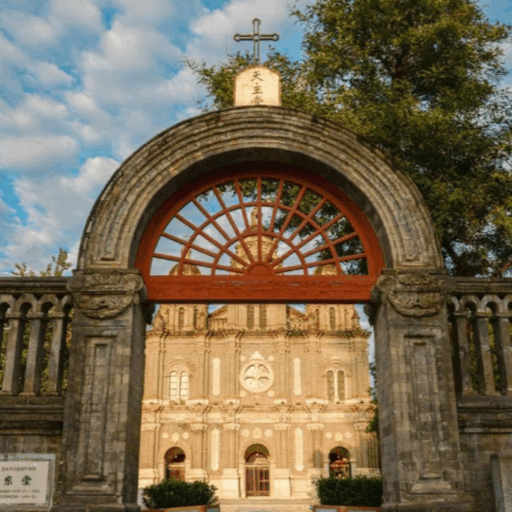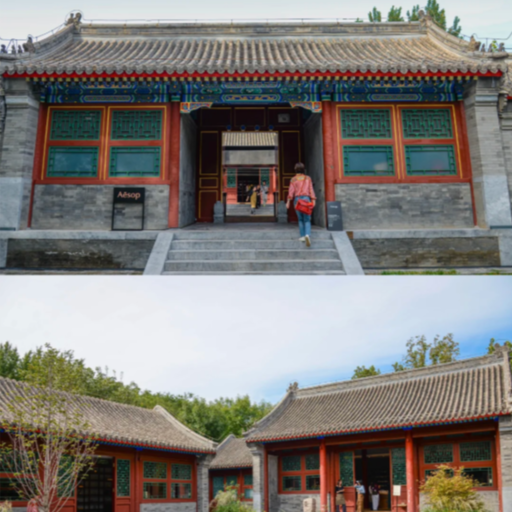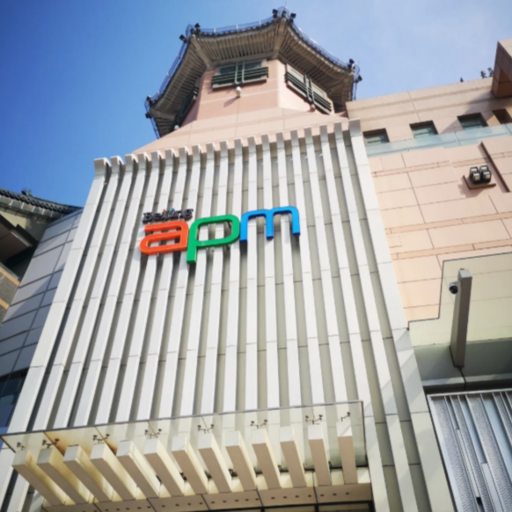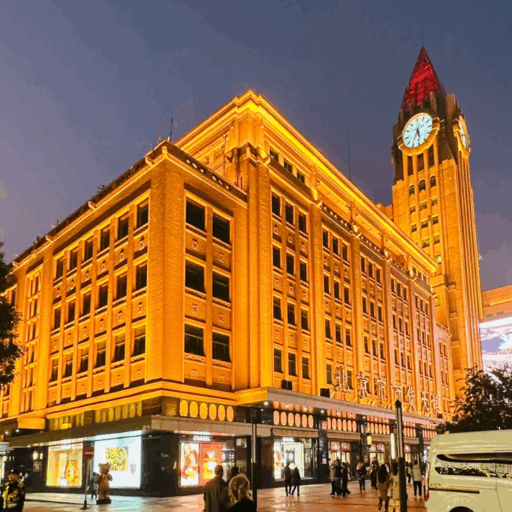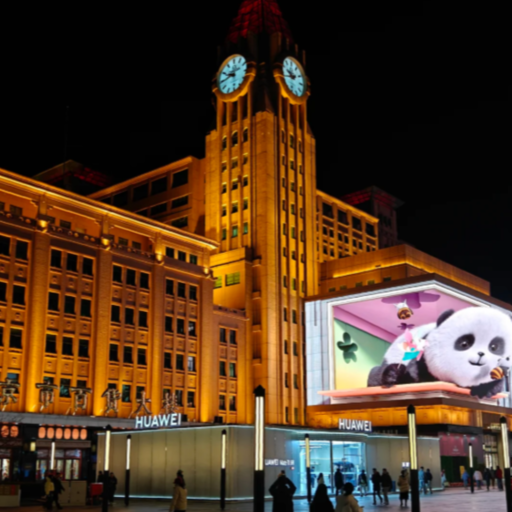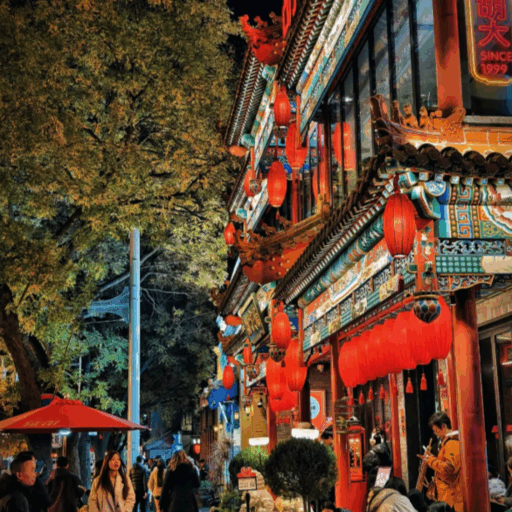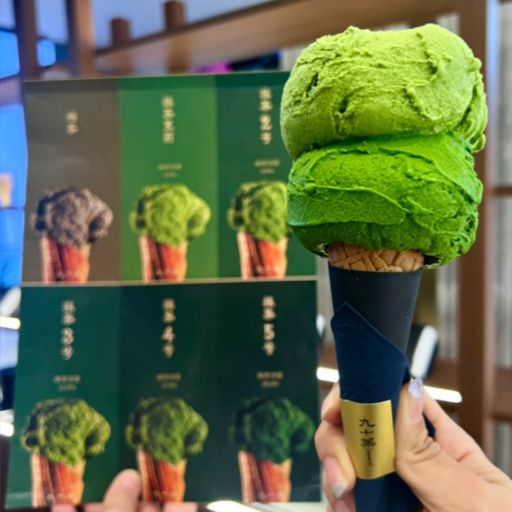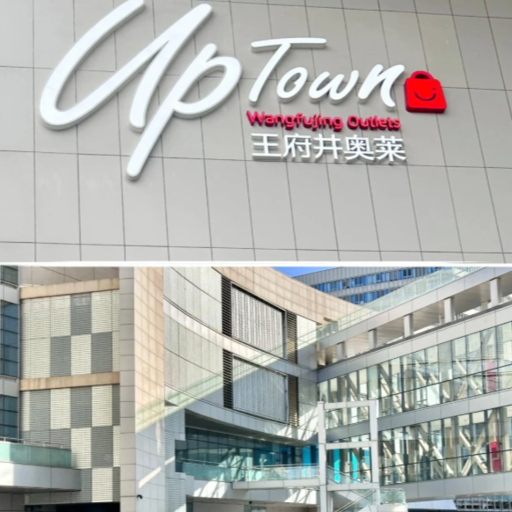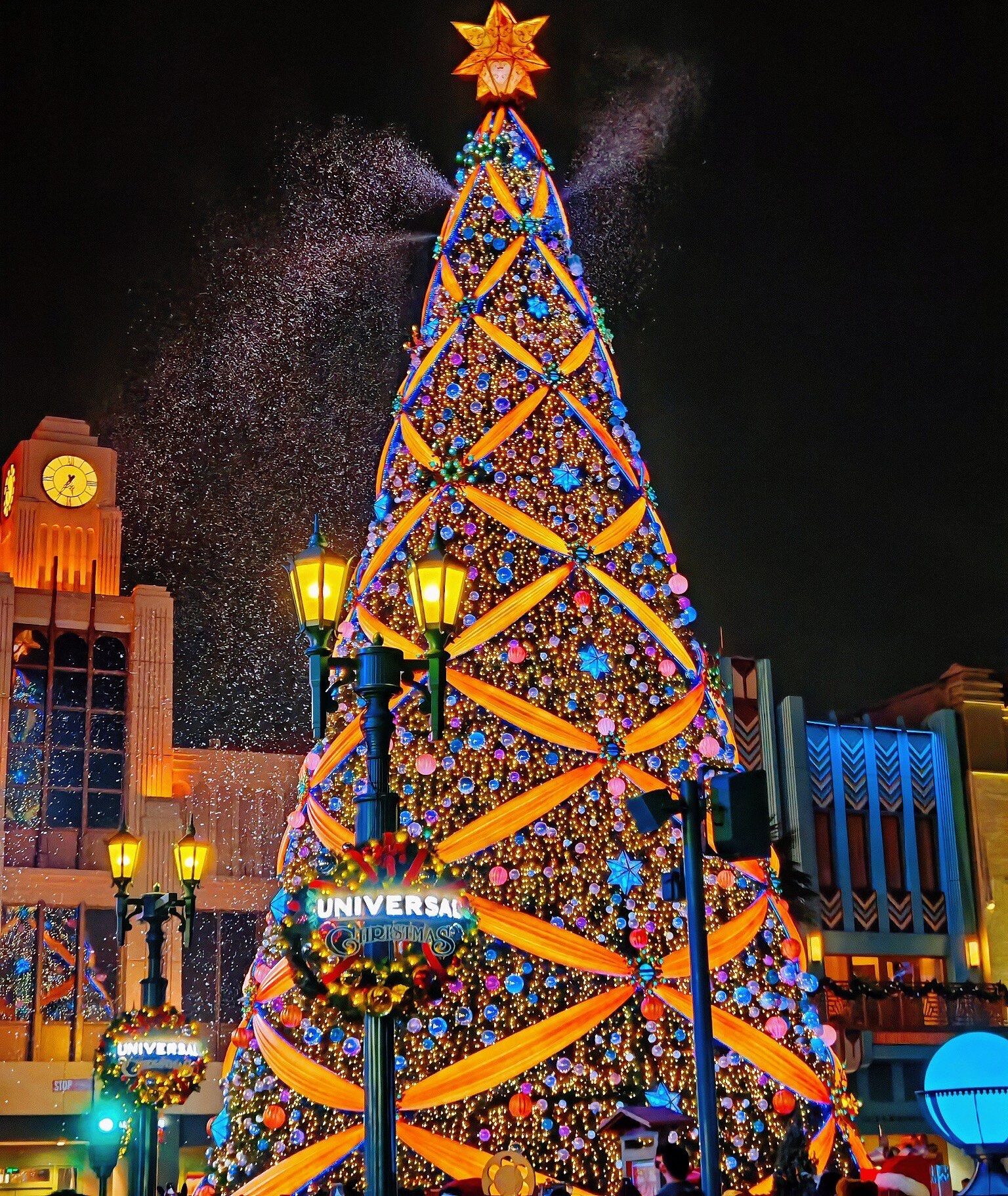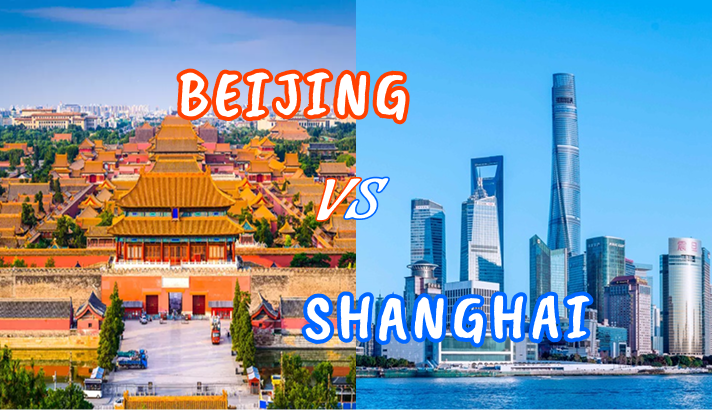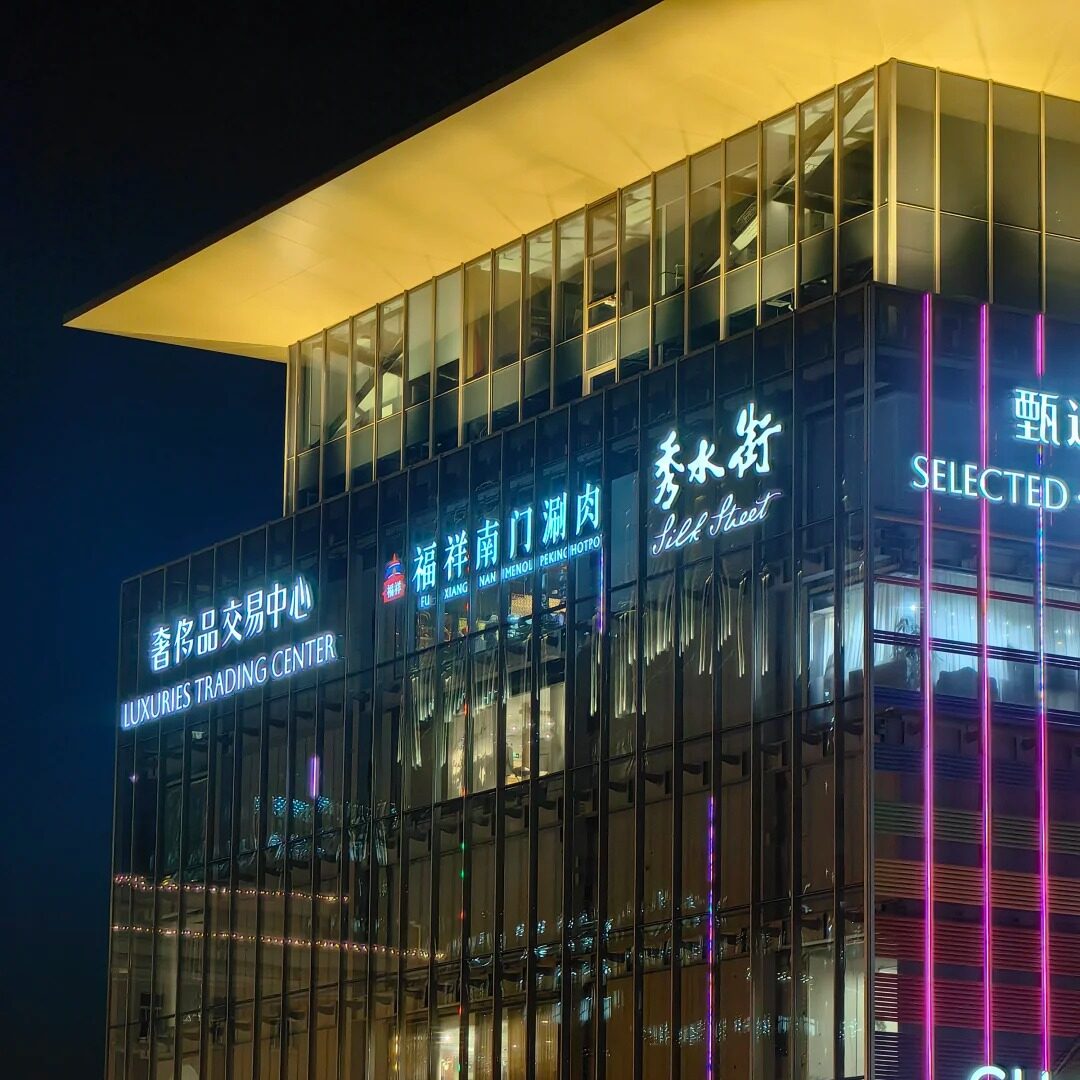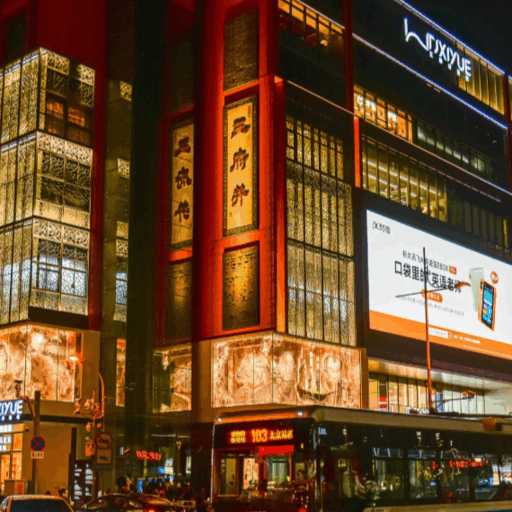
Wangfujing Street Beijing
If Beijing had a true center, it would be Wangfujing Street — an 1.8-kilometer stretch of pure city life. Just east of the Forbidden City, this pedestrian avenue brings together modern malls, old Beijing flavors, and endless crowds. You can find everything here: fashion brands, tea shops, bookstores, souvenir stalls, and the aroma of sizzling street food that drifts through the air. Vehicles are kept out, so visitors stroll freely among fountains, flowerbeds, and street sculptures. It may feel crowded or commercial at times, but when the neon lights glow and the food stalls come alive, Wangfujing Street Beijing shows its true charm — lively, colorful, and unmistakably the heart of the capital.
Quick Facts about Wangfujing Street
| Location | Dongcheng District, Beijing — about 1 km east of the Forbidden City. (wangfujing street beijing) |
| Opening Hours | Shops 10:00 AM – 10:00 PM; Wangfujing Street night market from 5:00 PM till late. |
| Ticket Information | Free to visit; some nearby spots like St. Joseph’s Church may have separate entry times. |
| How to Get There | Subway Line 1 → Wangfujing Station (Exit A); check wangfujing street map for easy routes. |
| Insider Tip | Prices at tourist stalls can be high; explore side alleys for authentic bites. |
The Origin and Story Behind Wangfujing Street
- Wangfujing Church
- Wangfujing Street Prince’s Mansion
From “Prince’s Mansion Well” to Beijing’s Main Avenue
There is a piece of Beijing’s imperial DNA in the name Wangfujing Street (王府井大街). “Wangfu” is “Prince’s Mansion,” and “Jing” is a “well.” In the Ming Dynasty, there were many royal mansions here, only one old well kept water in it. Locals gradually began referring to the place as “Wangfu Jing” — or, the well of the prince’s residences.
Beijing changed and so did Wangfujing Street Beijing, from a quiet well-to-do neighborhood to the bustling commercial district that it had become. Since the early 20th century, it had been home to some of the city’s earliest department stores and bookstores, drawing scholars and traders alike. Even now, as visitors walk stretches of its widened pavements lined by illuminated storefronts, they’re retracing layers of Wangfujing Street history — a street that has reflected each iteration in the metamorphosis from empire to metropolis faced by Beijing.
But beyond commerce, Wangfujing became a symbol of modernity in old Beijing — where the city’s elite once bought imported goods and read foreign newspapers. Its location just east of the Forbidden City put it at the center of urban life, connecting imperial Beijing and its cosmopolitan ambitions.
Traces of the Past Hidden in Modern Glass
Among the shiny malls and international brands, remnants of the old Wangfujing persist. Inside one of these old storefronts — whether Tongshenghe, a hundred-year-old shoe shop; or Shengxifu, strong in traditional hats — you can still feel the beat of old Beijing commerce: measured, proud and based on craftsmanship.
The street vendors with tanghulu (candied hawthorn skewers) are like a childhood flavor that has outlasted years of urban upheaval. The smell of roasted chestnuts in the winter or distant bicycle bells gives a bit of human warmth to an otherwise modern landscape. If you want to explore more of Beijing’s historical streets and hidden cultural layers, take a look at this guide to Beijing city tours for ideas beyond Wangfujing.
Even the architectural blend tells its tale: beneath the glass walls of malls, many branches of which are built on disused hutong-style courtyards, some now home to cafés or art boutiques. These layers, invisible ones and otherwise, are a subtle reminder to travelers that Wangfujing in Chinese means something more than just a shopping destination — that it is also a living museum of Beijing’s soul.
Whether you come seeking nostalgia or neon, Wangfujing has it — a street in which dynastic memory meets modern China, the one inviting every visitor to walk through Beijing’s timeline in half an hour.
What to See and Do on Wangfujing Street
- APM of Wangfujing
- Wangfujing Department Store
Walking the Main Pedestrian Street
Begin at St. Joseph’s Church, one of Beijing’s most beautiful sanctuaries and a tranquil counterpoint to the city’s ceaseless energy. The rhythm of the city packs you into its thrall when you take your first few steps on Wangfujing Street: voices, street music and the buzz of neon reflected off polished stone. Walk south toward APM Shopping Mall and scroll by flagship stores, bookstores and snack vendors all vying for your attention.
At night, the street is a different animal altogether. There are the lit arches, the red lanterns and the shops illuminated in a shimmering glow of Beijing cool air as if it’s straight out of a movie. Pairs walk hand in hand; tourists take selfies in front of Wangfujing Street attractions that mix faith, fashion and food. Every few steps there will be something new — a perfume shop next to a traditional tea seller or a luxury brand juxtaposed with a calligraphy store. It is the combination of these walks that makes Wangfujing shopping street so very special.
For first-time visitors, the best way to feel Wangfujing Street’s throbbing pulse is to walk it — from the solemn beauty of St. Joseph’s Church to the contemporary buzz of APM. You will cover less than a kilometer, yet travel through centuries of Beijing’s past.
The Blend of Tradition and Modern Retail
What sets Wangfujing Street Beijing apart is not just shopping — it’s the way that tradition and modernity intertwine. Century-old brands that tell stories of the city’s past stand next to futuristic glass buildings. Pop into Tongrentang (同仁堂), the famous Chinese medicine store dating back to 1669, filled with herbal fragrance and polished wooden shelves. Or explore Wangfujing Department Store, one of China’s first modern malls, where locals still buy household goods and gifts.
Across the street, Beijing APM and Oriental Plaza showcase the city’s international side, hosting stores like Apple, Zara, and H&M. Even here, you’ll notice local touches: red paper lanterns during Spring Festival, or pop-up markets serving Beijing-style snacks. This blend of old and new keeps Wangfujing shopping street vibrant, attracting nostalgic locals and holiday trend-chasers alike.
What’s interesting is that these places aren’t just commercial — they personify a changing Beijing. The ornate signs of traditional shops make cozy bedfellows with LED billboards, and the fustiness that can overtake other parts of Japan’s third-most populous city is nowhere to be found — this is a city that never forgets where it came from, even if it means zooming into the future.
Where Locals Go — Beyond the Obvious
If you’re looking to discover the way locals do Wangfunging Street, detour. Wander down into the tiny alleys just off the main road and you will find another side of the district — more quiet, more intimate, full of surprises.
Just north of the main avenue, locals love the Wangfujing Snack Street. Here, you can try roasted chestnuts and sugar-coated fruit, fried tofu — or something a bit more daring, like scorpion skewers (mostly for tourists, but fun to see). A bit farther in, small tea houses and indie coffee shops provide respite from the throng.
Highly rated on TripAdvisor is the Foreign Languages Bookstore, where travelers can browse items ranging from art prints to Chinese calligraphy guides. “Behind a small alley there is a Roast Duck Café of Hutong hidden in an alley” — a combination of vintage decor and pungent aroma that locals swear by.
Visitors frequently tell us that Wangfujing Street attractions are much more than meets the eye from the main street. The backstreets are what make the biggest intake of breath, with handwritten menus, nostalgic decorations and friendly shopkeepers.
So as the grand pedestrian avenue dazzles with its lights and luxury, you find the true Wangfujing Street just a few steps away where modern Beijing still murmurs to its past.
Food Scene at Wangfujing — Between Hype and Authenticity
- Wangfujing Night Scene
- Guijie (Ghost Street) Night Market
The Night Market Everyone Talks About
No visit to Beijing is complete without sampling its street food — and Wangfujing Street Food has generated something of a reputation with every tourist. The Wangfujing night market, illuminated by red lanterns and paper signs, offers a full-on sensory assault: sizzling woks, the scent of fried dough and vendors shouting their specialties in English and Mandarin. The going rate is usually ¥30–80, depending on what you go for — some stalls may “accidentally” quote higher to curious foreigners.
There are sticks of lamb, squid, tofu and the notorious scorpion-on-a-stick. The scorpion trend, popular on Instagram, is more of a tourist gimmick than an actual element of Beijing’s street food scene at this point. Locals seldom dine upon it — it is there largely to be gawked at. The same could be said of deep-fried seahorses or starfish, which feel exotic but end up tasting like overcooked batter. If you want a deeper look at other bustling night markets in Beijing, including hidden gems and local favorites, check out this guide to night markets in Beijing.
But the market is worth visiting once and simply for the experience. It’s not in its flavor, but in the energy of it: the clang-clang of metal skewers, the scent of caramelizing sugar and bright smoke rising under neon light. It’s disorderly, it’s packed and ever so slightly theatrical — and yet it is part of the charm of Wangfujing night market.
Where to Find Real Local Flavors
For real Beijing street food, venture beyond the famed Wangfujing snack street Beijing and discover where locals eat. A short taxi ride away is Guijie (簋街), a 24-hour food street near Dongzhimen known for spicy crawfish, hotpot and stir-fried dishes. Here, menus are seldom translated and the greatest sign of quality is a queue of locals at midnight. The prices are reasonable, the portions are huge and the food — it’s authentic Beijing.
Another local staple is Di’anmen Food Street (地安门美食街), where you can feast on classic northern eats such as zhajiangmian (noodles with soybean paste), baozi (steamed buns) and tanghulu (candied hawthorn skewers) prepared the old-fashioned way. These options may lack the glitzy appearance of Wangfujing, but they serve up the flavors that Beijingers grew up on.
To tell “real” Beijing food versus pot-holed tourist stuff, look for three clues:
- Locals are eating there. Tourists take photographs; locals takes seats.
- Simple setup, strong aroma. Proper vendors focus on the wok, not the signboard.
- Cash or local e-pay only. Most legit stalls can’t be asked to deal with cards or “We speak English” stickers.
Even within Wangfujing Street’s shopping area, hidden gems await — tiny dumpling stalls behind towering malls, or dessert stands run by families for generations. For a truly memorable bite, try donkey burger (驴肉火烧) or fried batter cake (焦圈) in small side alleys; these capture the genuine warmth of Beijing’s culinary heart.
In the end, Wangfujing Street food offers fun through sights, smells, and atmosphere, but the real flavors lie elsewhere. The night market is the postcard, while authentic Beijing street food thrives a few blocks south, where crowds thin and tastes deepen.
Shopping Guide — From Souvenirs to Silk
- Wangfujing Ice Cream Shop
- Wangfujing Outlets
The shops on Wangfujing have something for everyone. In terms of souvenirs, the Beijing shopping street has keychains, silk scarves, fans and miniature pagoda trinkets for around ¥20–100 each. For more genuine souvenirs, venerable shops like Beijing Tongrentang or small side-street stalls offer handcrafted tea sets and embroidered silk bookmarks and other locally made treasures — bonafide Wangfujing souvenirs.
World)by- APM, Wangfujing Department Store and Oriental Plaza with stuff that’s more in keeping with taste buds worldwide: designer fashion, cosmetics and electronic whizbangs. Some stores offer tax refunds to help balance the costs of higher-end purchases for visitors. Designer scarves or silk goods here can run you ¥500–1,200 – for quality and brand name price tag.
For budget-oriented customers, the winding alleyways and discrete stores that the shopping district has more of its numerous small tea shops, specialty bookstores and traditional craft stalls offer a more intimate setting. Conversations with shopkeepers often yield product stories and history, giving your shopping trip a little more depth.
In a nutshell Wangfujing shopping affords showy main-street glamour and quiet, authentic finds mingled in. Whether souvenir shopping, silk hunting or browsing local specialties, visiting both sides adds up to a richer whole for the visitor who wants to take in all the shades of Beijing retail culture.
Hidden Pitfalls & Smart Tips for Visiting Wangfujing Street
Overpriced Snacks and Souvenir Stalls
Striding on Wangfujing Street Beijing China, you will get easily attracted by colorful snack stands and souvenir shops. Food on a stick, sweet fruit and trinkets frequently have a 30–50 percent price hike – higher than what’s locals pay. As an example, a sugar-coated hawthorn stick could go for ¥20–25 at a main-street stall versus just ¥10–15 in the lane one over. To keep from overspending, compare with a few vendors before purchasing, and don’t hesitate to negotiate politely. For genuine Wangfujinq souvenirs and snacks that won’t rip you off, stick with old-tmr favorites – quality tends to be better, prices fairer.
The Photo Trap — “Free” Performances That Aren’t
Local buskers provide a slight entertainment to Wangfujing night market, yet there is something slightly more that you might not have remembered. Anybody can insist on being paid after having a photo taken with him or her, participating in their performance among others. Customers at TripAdvisor have often expressed dissatisfaction with being given tips that they did not expect to pay after taking pictures. Rule of thumb: ask or simply observe at a distance. It makes the experience light and does not include awkward moments.
Smarter Ways to Explore
To gain more authenticity and avoid scams in Beijing, use local apps like Dianping or XiaoHongShu English version to find recommended food spots, shops, and side streets. Instead of sticking to the main pedestrian lane, walk through nearby hutongs; there, hidden vendors, traditional snack stalls, and small artisan shops await without the usual crowds. This approach lets you experience real Wangfujing street culture — pungent, less commercialized, and friendlier to your wallet.
With a bit of planning, local insights, and some street-savvy sense, you can dive into the buzz of Wangfujing Street while sidestepping its most common tourist traps.
FAQ about Wangfujing Street
Q: What is Wangfujing more known for?
Wangfujing Street is known for its combination of modern shopping and traditional Beijing culture. Visitors come to see global brands along with historic shops like Tongrentang, watch street performances and taste snacks in the Wangfujing Street night market. It’s not just a shopping street; it’s an urban snapshot, capturing Beijing’s history, architecture and ability to support crowds of people on foot.
Q: Is Wangfujing Street worth visiting?
Yes, but with a strategy. This main pedestrian street can be both crowded and touristy, but it’s a memorable experience the first time. Walking the main avenue and side alleys brings visitors to some of Beijing’s most authentic snacks, as well as small artisan shops. There’s enough to see, buy and eat along with a cross-supporting cast of both locals as well as spectacle if you avoid the overpriced shopstalls … by all means get there Wangfujing Street.
Q: What time does Wangfujing Street open?
Most shops are open from 10am until 10pm. The Wangfujing night market isn't kind of operational by 5:00pm and goes past midnight (all depending on season and weather). Weekends are the grid’s busiest times, so early evening visits promise both bright light traffic and slightly sparser hordes.
Q: How to go from the Forbidden City to Wangfujing Street?
A 1 km walk east from the Forbidden City. For quicker access, ride Subway Line 1 to Wangfujing Station, Exit A. Taxis or bike shares are easy alternatives. Walking will also allow you to visit nearby landmarks, such as St. Joseph’s Church and historic side streets.
Q: What to eat at Wangfujing night market?
Sample candies hawthorn skewers, fried tofu, roast chestnuts and other local snacks. Be wary of the exotic menu items — scorpions, riding a tourist dollar rather than a culinary wave. Most authentic Beijing street food experiences can be found in side alleys and similar streets (such as Guijie).
Q: Can I pay by credit card when shopping at Wangfujing stores?
International malls like APM and Wangfujing Department Store do accept cards, but street vendors and hole-in-the-wall shops commonly prefer cash or local e-pay. Keep a bit of RMB cash with you or have WeChat Pay/Alipay working for that extra flexibility.
Q: Can foreigners use WeChat Pay or Alipay there?
Yes, travelers can add passports and international cards to both apps. Most street vendors and small stores will accept them, though a few may still prefer cash. It’s close for Wangfujing shopping, and small street purchases.
Q: Is it safe to visit Wangfujing at night?
Mostly safe — the street is well-lit and heavily patrolled. Pickpockets can be prevalent in crowded areas, so keep bags secure. Side streets are fine as well, especially in the vicinity of where locals eat and shop.
Q: Where to stay near Wangfujing Street (foreign-friendly hotels)?
Foreign tourist prefer to stay in Beijing Hotel, Novotel Beijing Peace or Holiday Inn Express in the area. They offer easy walking access to things to do near Wangfujing Street, staff that speaks English and international facilities.
Q: What’s the best souvenir to buy at Wangfujing?
Seek out handmade silk scarves, tea sets and Beijing-style snacks at old stores. Stay away from generic tourist souvenirs and look for products that reflect the history of Wangfujing Street Beijing China.
